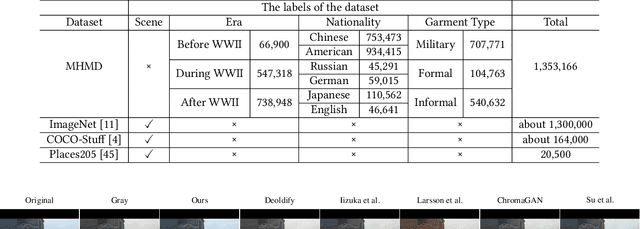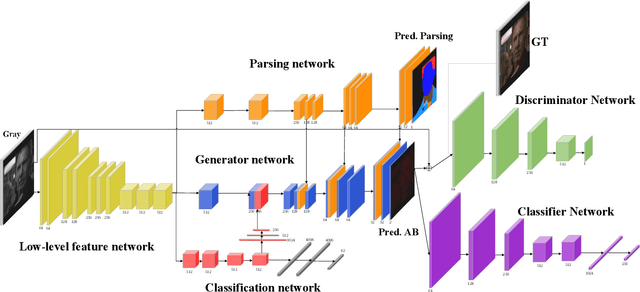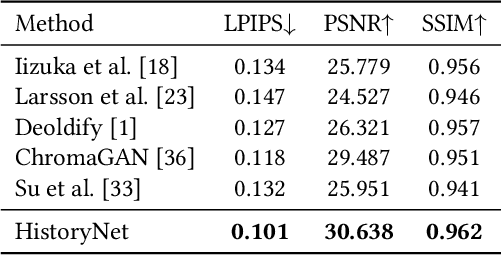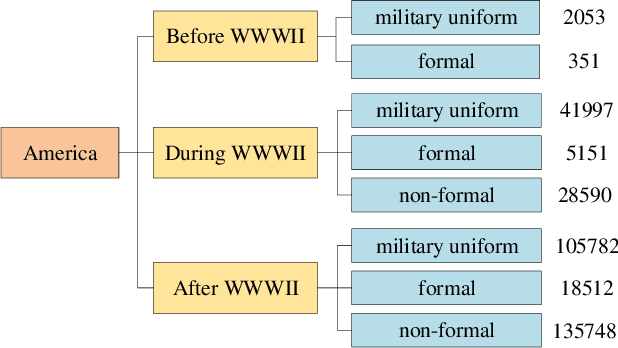Ziyin Zhou
AIGI-Holmes: Towards Explainable and Generalizable AI-Generated Image Detection via Multimodal Large Language Models
Jul 03, 2025Abstract:The rapid development of AI-generated content (AIGC) technology has led to the misuse of highly realistic AI-generated images (AIGI) in spreading misinformation, posing a threat to public information security. Although existing AIGI detection techniques are generally effective, they face two issues: 1) a lack of human-verifiable explanations, and 2) a lack of generalization in the latest generation technology. To address these issues, we introduce a large-scale and comprehensive dataset, Holmes-Set, which includes the Holmes-SFTSet, an instruction-tuning dataset with explanations on whether images are AI-generated, and the Holmes-DPOSet, a human-aligned preference dataset. Our work introduces an efficient data annotation method called the Multi-Expert Jury, enhancing data generation through structured MLLM explanations and quality control via cross-model evaluation, expert defect filtering, and human preference modification. In addition, we propose Holmes Pipeline, a meticulously designed three-stage training framework comprising visual expert pre-training, supervised fine-tuning, and direct preference optimization. Holmes Pipeline adapts multimodal large language models (MLLMs) for AIGI detection while generating human-verifiable and human-aligned explanations, ultimately yielding our model AIGI-Holmes. During the inference stage, we introduce a collaborative decoding strategy that integrates the model perception of the visual expert with the semantic reasoning of MLLMs, further enhancing the generalization capabilities. Extensive experiments on three benchmarks validate the effectiveness of our AIGI-Holmes.
FL-PLAS: Federated Learning with Partial Layer Aggregation for Backdoor Defense Against High-Ratio Malicious Clients
May 17, 2025Abstract:Federated learning (FL) is gaining increasing attention as an emerging collaborative machine learning approach, particularly in the context of large-scale computing and data systems. However, the fundamental algorithm of FL, Federated Averaging (FedAvg), is susceptible to backdoor attacks. Although researchers have proposed numerous defense algorithms, two significant challenges remain. The attack is becoming more stealthy and harder to detect, and current defense methods are unable to handle 50\% or more malicious users or assume an auxiliary server dataset. To address these challenges, we propose a novel defense algorithm, FL-PLAS, \textbf{F}ederated \textbf{L}earning based on \textbf{P}artial\textbf{ L}ayer \textbf{A}ggregation \textbf{S}trategy. In particular, we divide the local model into a feature extractor and a classifier. In each iteration, the clients only upload the parameters of a feature extractor after local training. The server then aggregates these local parameters and returns the results to the clients. Each client retains its own classifier layer, ensuring that the backdoor labels do not impact other clients. We assess the effectiveness of FL-PLAS against state-of-the-art (SOTA) backdoor attacks on three image datasets and compare our approach to six defense strategies. The results of the experiment demonstrate that our methods can effectively protect local models from backdoor attacks. Without requiring any auxiliary dataset for the server, our method achieves a high main-task accuracy with a lower backdoor accuracy even under the condition of 90\% malicious users with the attacks of trigger, semantic and edge-case.
Exploring the Collaborative Advantage of Low-level Information on Generalizable AI-Generated Image Detection
Apr 01, 2025Abstract:Existing state-of-the-art AI-Generated image detection methods mostly consider extracting low-level information from RGB images to help improve the generalization of AI-Generated image detection, such as noise patterns. However, these methods often consider only a single type of low-level information, which may lead to suboptimal generalization. Through empirical analysis, we have discovered a key insight: different low-level information often exhibits generalization capabilities for different types of forgeries. Furthermore, we found that simple fusion strategies are insufficient to leverage the detection advantages of each low-level and high-level information for various forgery types. Therefore, we propose the Adaptive Low-level Experts Injection (ALEI) framework. Our approach introduces Lora Experts, enabling the backbone network, which is trained with high-level semantic RGB images, to accept and learn knowledge from different low-level information. We utilize a cross-attention method to adaptively fuse these features at intermediate layers. To prevent the backbone network from losing the modeling capabilities of different low-level features during the later stages of modeling, we developed a Low-level Information Adapter that interacts with the features extracted by the backbone network. Finally, we propose Dynamic Feature Selection, which dynamically selects the most suitable features for detecting the current image to maximize generalization detection capability. Extensive experiments demonstrate that our method, finetuned on only four categories of mainstream ProGAN data, performs excellently and achieves state-of-the-art results on multiple datasets containing unseen GAN and Diffusion methods.
StealthDiffusion: Towards Evading Diffusion Forensic Detection through Diffusion Model
Aug 11, 2024Abstract:The rapid progress in generative models has given rise to the critical task of AI-Generated Content Stealth (AIGC-S), which aims to create AI-generated images that can evade both forensic detectors and human inspection. This task is crucial for understanding the vulnerabilities of existing detection methods and developing more robust techniques. However, current adversarial attacks often introduce visible noise, have poor transferability, and fail to address spectral differences between AI-generated and genuine images. To address this, we propose StealthDiffusion, a framework based on stable diffusion that modifies AI-generated images into high-quality, imperceptible adversarial examples capable of evading state-of-the-art forensic detectors. StealthDiffusion comprises two main components: Latent Adversarial Optimization, which generates adversarial perturbations in the latent space of stable diffusion, and Control-VAE, a module that reduces spectral differences between the generated adversarial images and genuine images without affecting the original diffusion model's generation process. Extensive experiments show that StealthDiffusion is effective in both white-box and black-box settings, transforming AI-generated images into high-quality adversarial forgeries with frequency spectra similar to genuine images. These forgeries are classified as genuine by advanced forensic classifiers and are difficult for humans to distinguish.
Can't say cant? Measuring and Reasoning of Dark Jargons in Large Language Models
Apr 25, 2024



Abstract:Ensuring the resilience of Large Language Models (LLMs) against malicious exploitation is paramount, with recent focus on mitigating offensive responses. Yet, the understanding of cant or dark jargon remains unexplored. This paper introduces a domain-specific Cant dataset and CantCounter evaluation framework, employing Fine-Tuning, Co-Tuning, Data-Diffusion, and Data-Analysis stages. Experiments reveal LLMs, including ChatGPT, are susceptible to cant bypassing filters, with varying recognition accuracy influenced by question types, setups, and prompt clues. Updated models exhibit higher acceptance rates for cant queries. Moreover, LLM reactions differ across domains, e.g., reluctance to engage in racism versus LGBT topics. These findings underscore LLMs' understanding of cant and reflect training data characteristics and vendor approaches to sensitive topics. Additionally, we assess LLMs' ability to demonstrate reasoning capabilities. Access to our datasets and code is available at https://github.com/cistineup/CantCounter.
DiffusionFace: Towards a Comprehensive Dataset for Diffusion-Based Face Forgery Analysis
Mar 27, 2024



Abstract:The rapid progress in deep learning has given rise to hyper-realistic facial forgery methods, leading to concerns related to misinformation and security risks. Existing face forgery datasets have limitations in generating high-quality facial images and addressing the challenges posed by evolving generative techniques. To combat this, we present DiffusionFace, the first diffusion-based face forgery dataset, covering various forgery categories, including unconditional and Text Guide facial image generation, Img2Img, Inpaint, and Diffusion-based facial exchange algorithms. Our DiffusionFace dataset stands out with its extensive collection of 11 diffusion models and the high-quality of the generated images, providing essential metadata and a real-world internet-sourced forgery facial image dataset for evaluation. Additionally, we provide an in-depth analysis of the data and introduce practical evaluation protocols to rigorously assess discriminative models' effectiveness in detecting counterfeit facial images, aiming to enhance security in facial image authentication processes. The dataset is available for download at \url{https://github.com/Rapisurazurite/DiffFace}.
Variance-insensitive and Target-preserving Mask Refinement for Interactive Image Segmentation
Dec 22, 2023Abstract:Point-based interactive image segmentation can ease the burden of mask annotation in applications such as semantic segmentation and image editing. However, fully extracting the target mask with limited user inputs remains challenging. We introduce a novel method, Variance-Insensitive and Target-Preserving Mask Refinement to enhance segmentation quality with fewer user inputs. Regarding the last segmentation result as the initial mask, an iterative refinement process is commonly employed to continually enhance the initial mask. Nevertheless, conventional techniques suffer from sensitivity to the variance in the initial mask. To circumvent this problem, our proposed method incorporates a mask matching algorithm for ensuring consistent inferences from different types of initial masks. We also introduce a target-aware zooming algorithm to preserve object information during downsampling, balancing efficiency and accuracy. Experiments on GrabCut, Berkeley, SBD, and DAVIS datasets demonstrate our method's state-of-the-art performance in interactive image segmentation.
Focusing on Persons: Colorizing Old Images Learning from Modern Historical Movies
Aug 14, 2021



Abstract:In industry, there exist plenty of scenarios where old gray photos need to be automatically colored, such as video sites and archives. In this paper, we present the HistoryNet focusing on historical person's diverse high fidelity clothing colorization based on fine grained semantic understanding and prior. Colorization of historical persons is realistic and practical, however, existing methods do not perform well in the regards. In this paper, a HistoryNet including three parts, namely, classification, fine grained semantic parsing and colorization, is proposed. Classification sub-module supplies classifying of images according to the eras, nationalities and garment types; Parsing sub-network supplies the semantic for person contours, clothing and background in the image to achieve more accurate colorization of clothes and persons and prevent color overflow. In the training process, we integrate classification and semantic parsing features into the coloring generation network to improve colorization. Through the design of classification and parsing subnetwork, the accuracy of image colorization can be improved and the boundary of each part of image can be more clearly. Moreover, we also propose a novel Modern Historical Movies Dataset (MHMD) containing 1,353,166 images and 42 labels of eras, nationalities, and garment types for automatic colorization from 147 historical movies or TV series made in modern time. Various quantitative and qualitative comparisons demonstrate that our method outperforms the state-of-the-art colorization methods, especially on military uniforms, which has correct colors according to the historical literatures.
 Add to Chrome
Add to Chrome Add to Firefox
Add to Firefox Add to Edge
Add to Edge